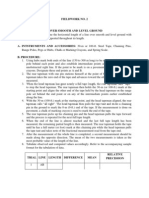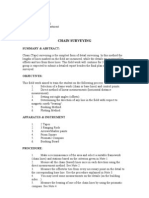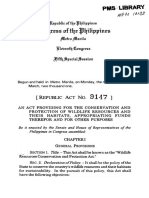4
4
Uploaded by
Michael John MirandaCopyright:
Available Formats
4
4
Uploaded by
Michael John MirandaOriginal Description:
Copyright
Available Formats
Share this document
Did you find this document useful?
Is this content inappropriate?
Copyright:
Available Formats
4
4
Uploaded by
Michael John MirandaCopyright:
Available Formats
2.
6 measure distances by chaining
1. As you have learned, measuring lines can be ropes, bands, tapes or surveyor's
chains. When you measure long distances, the way you use the measuring line will
depend on the slope of the terrain. When the terrain is flat or nearly flat (that is, with a
slope of 5 percent or less , you can measure the horizontal distances by following the
ground surface. This method is usually used in measuring fish culture sites, where
steeper slopes must be avoided. When the slope of the terrain is steeper than 5 percent,
you should be especially careful when you measure the horizontal distances because in
this case the surface measurement is always greater than the horizontal measurement.
On flat ground, measure directly
... the surface measurement is longer
The horizontal distance is the true
measurement...
Chaining over horizontal ground
2. Mark each straight line you need to
measure with a ranging pole at each end.
On lines longer than 50 m, place
intermediate markers at regular intervals,
3. To measure long distances accurately,
you will need marking pins. You can use
thin wooden stakes about 25 cm long,
which you can easily carry in a small
basket. These marking pins will be driven
vertically into the ground as you proceed
with the chaining.
4. Chaining is carried out by two persons,
a rear
chainman and
a head
chainman. The
rear chainmanis
responsible for the measurements. He
notes the results. He also guides the head
chainman to
make
sure
that
the
consecutive measurements are made
exactly along straight lines between the
marked ground points.
5. Start the measurements at one end of
the straight line. Remove the ranging pole
and drive the first marking pin into the
ground at exactly the same point.
6. The rear chainman places his end of
the measuring line against this marking
pin. The head chainman, taking with him a
number of marking pins, walks away along
the straight line with the other end of the
measuring line.
7. The head chainman stops when the
measuring line is stretched out tightly to its
full length on the ground. He then looks
towards the rear chainman. If the
measuring line is not placed exactly along
the straight line, the rear chainman then
tells the head chainman how to correct the
position of the measuring line.
The rear chainman stays at the first point...
... and helps the head chainman find the second
point
8. When the measuring line is correctly
placed, the rear chainman signals to the
head chainman toplace a second marking
pin at the end of the measuring line.
9. The rear chainman immediately notes
down this measurement.
When the second pin is placed...
10. The rear chainman then removes the
first marking pin, putting it in his basket,
and replaces the ranging pole at the
starting point.
... the rear chainman notes the
measurement
... and puts the first pin in his basket...
11. Still holding their ends of the
measuring line, both chainmen move
forward along the straight line,always
keeping
the
measuring
line
well
stretched. This is particularly important
when using a surveyor's chain.
12. The rear chainman stops at the second
marking pin and places his end of the
measuring line against it.
13. The head chainman tightens the
measuring line along the ground, corrects
its position following any directions from
the rear chainman, and places a third
marking pin at the end of the measuring
line when signalled to do so.
Both chainman move forward...
... to measure the distance between
the second and third pins
14. The rear chainman notes down this
measurement. Then he puts the second
marking pin in his basket before moving
on.
15. The process in steps 10 to 14 should
be repeated along each section of the
straight line until the end is reached.
The head chainman notes each distance
Note 1: when the end of the line is
reached, the number of marking pins in the
basket of the rear chainman shows the
number of complete measuring-line lengths
measured. You can use this to check on
the measurements noted down.
a set of 11 marking
pins makes it easier to keep track of the
number of measurements completed.
When the rear chainman has ten pins in
his basket, ten complete measuring-line
lengths have been measured. He notes
this down and gives the ten pins back to
the head chainman, leaving the eleventh
pin in the ground; this is the starting point
of a new series of measurements.
Note
2: using
The number of pins in the basket helps
you keep count
10 chain lengths have been measured
Example
Using a chain 10 m long, the rear chainman
has marked 4 x 10 pins in his notebook. He
has 6 marking pins in his basket. At the
marking pin still in the ground, he has
measured a distance of (4 x 10) + 6 = 46 chain
lengths or 46 x 10 m = 460 m.
Chaining over sloping ground
16. When you are measuring on
ground with a slope greater than 5
percent (see Section 4.0), you will need to
use the measuring line differently to find
the horizontal distances.
17. Proceed as described in the previous
section. Mark the straight lines with
ranging poles at each end and
intermediate pegs. Remember to work
downhill for greater accuracy.
18. The head chainman should hold the
measuring line horizontal, above the
ground, in this case.
19. When the measuring line is in the right
place and is fully stretched, the head
chainman finds the exact point on which to
place the marking pin, using a plumbline (see Section 4.8).
20. Keep proceeding in this way along the
slope.
steep slopes, use a shorter
measuring line (such as 5 m, rather than
10 m).
Note: on
21. As you measure on sloping ground, remember these important requirements:
horizontal measuring line;
Horizontal measuring line
well-stretched measuring line;
Well-stretched measuring line
exact placement of the marking pins.
Note: you
may also measure along the
ground on a slope. But to obtain horizontal
distances, you will need to correct these
ground
measurements
afterwards
by
using mathematical formulas .
Exact placement of the marking pins
Chaining over irregular ground
22. You may need to measure distances
over irregular ground that has ridges,
mounds, rocks, trenches or streams in the
way. In such cases, you need to lift the
measuring line above the obstacle. Make
sure that you do the following:
keep the measuring line well
stretched. The head chainman may
shorten it by looping it in his hand if
necessary;
keep the line horizontal, using a
mason's level for the best accuracy
(see Section 6.1);
lift the back end of the measuring
line exactly above the marking
pin, using
a plumb-fine if
necessary (see Section 4.8).
23. Instead of using a plumb-line, you
can use longer marking pins, such as
ranging poles, set vertically in the
ground.
Ranging poles are taller than marking pegs
24. In very hard or rocky soils, you will
not be able to use marking pins. In such
cases, mark t he points with objects you
can see easily, such as painted rocks or
blocks of wood. Make sure that your
markers will not blow or roll away. Or,
you can make a mark on the ground with
a stick, or make a mark on a rock with
chalk.
Painted rock or block
Improving the accuracy of your chaining
25. To make your chaining more accurate,
you should repeat the measurements at
least once; start measuring at the point
where you finished, and continue back
along the line. This second measurement
should not differ too much from the first
one (see Chart below).
Measure twice for accuracy
26. If the two measurements agree, you
can calculate their average value. The
average value is taken as the true
measured distance.
Maximum permissible difference between two
consecutive
distance measurements, per 100 m
Steel band or tape 0.1 m
AB + BA = Average
2
Other tape
0.2 m
Surveyor's chain
0.2 m
Home-made rope
1.0 m
Example
Using a surveyor's chain, you take the
following measurements:
first measurement: 312.6 m;
second measurement: 313.2 m;
real difference: 313.2 m - 312.6 m =
First measurement
0.6 m;
acceptable difference: 0.2 m x (312.6
m
100)
= 0.2 m x 3.12 m = 0.62 m
which is larger than the real difference
and therefore agrees;
average distance: (312.6 m + 313.2
m) 2 = 312.9 m
Second measurement
27. If the two measurements differ by too
much, you should take a third
measurement. Compare this with the first
two measurements. Then calculate the
average value from the two most similar
values, as shown above.
First measurement
Example
Chaining with a steel tape, you take the
following measurements:
first measurement: 754.4 m;
second measurement: 753.2 m;
real difference: 754.4 m - 753.2 m =
1.2 m;
acceptable difference: 0.1 m x 7.54 m
= 0.75 m, which is smaller than the
Second measurement
Third measurement
real difference and therefore does not
agree;
third measurement: 753.9 m;
difference 754.4 - 753.9 m = 0.5 m
28. If you find you have very different
measurements of the same line, you may not
have been measuring along the true straight
line. To reduce such errors, put more ranging
poles on the line between the endpoints. If you
tie white or brightly coloured pieces of cloth to
the poles, you will be able to see them better.
Also, be sure to guide the head chainman
carefully as you measure.
A crooked line gives the wrong measurement
More ranging poles increase your accuracy
Flags make sighting easier
29. Further improve the accuracy of your
measurements by:
inspecting the full length of the measuring
line before using it to measure a series of
straight lines;
keeping
a uniform tension
on
the
measuring line during each measurement;
accurately marking each
point
of
Check your line before use
measurement;
keeping an accurate count of these points;
using the right device, such as a ruler, to
measure distances
less
than
the
measuring-line length, and knowing how
to read the graduations on it (see Section
2.1).
Note: it is better if the head chainman holds
the zero end of the measuring line. The rear
chainman can then directly make and note
down any intermediate readings.
Always stretch it tight
Mark and count points accurately
You might also like
- Chain Surveying ReportDocument3 pagesChain Surveying ReportAthiyo Martin64% (25)
- List of All Philippine Government AgenciesDocument5 pagesList of All Philippine Government AgenciesMichael John Miranda100% (1)
- Geography Map ReadingDocument20 pagesGeography Map ReadingWakale Nzako100% (1)
- (Original For Recipient) : Sl. No Description Unit Price Discount Qty Net Amount Tax Rate Tax Type Tax Amount Total AmountDocument1 page(Original For Recipient) : Sl. No Description Unit Price Discount Qty Net Amount Tax Rate Tax Type Tax Amount Total Amount50. Atharva Patel100% (1)
- Chapter Two: Measuring Horizontal DistanceDocument18 pagesChapter Two: Measuring Horizontal DistanceWelday Gebremichael100% (2)
- Exer6-Taping Over Uneven and Sloping GroundDocument6 pagesExer6-Taping Over Uneven and Sloping GroundMarney Lamoste Duaso100% (2)
- Medical Statistics - For Beginners - 1st Ed - 2017 PDFDocument188 pagesMedical Statistics - For Beginners - 1st Ed - 2017 PDFAdrianFratea100% (2)
- Renault India Private Limited: Detailed ReportDocument13 pagesRenault India Private Limited: Detailed Reportb0gm3n0tNo ratings yet
- Field Work 2Document2 pagesField Work 2Lucius Go TirolNo ratings yet
- Chain SurveyingDocument3 pagesChain SurveyingAhmadGhanem100% (1)
- Fieldwork NoDocument2 pagesFieldwork NoMelvin Esguerra50% (4)
- FD3Document5 pagesFD3Vince Rabin CandidatoNo ratings yet
- Lab 2 Taping Over Smooth and Level GroundDocument2 pagesLab 2 Taping Over Smooth and Level GroundRainiel MontalbaNo ratings yet
- Joanne Karla Jimenez - ENSC 234-LABORATORY NO.4Document2 pagesJoanne Karla Jimenez - ENSC 234-LABORATORY NO.4Joanne JimenezNo ratings yet
- Measuring Horizontal DistancesDocument37 pagesMeasuring Horizontal DistancesPHEBY MOOGNo ratings yet
- Taping On Even or Level Ground and Taping On Uneven or Sloping GroundDocument6 pagesTaping On Even or Level Ground and Taping On Uneven or Sloping GroundChristian Nathaniel Ramon PalmaNo ratings yet
- Field Work 2Document12 pagesField Work 2Paulo Remulla50% (2)
- Fieldwork 2Document3 pagesFieldwork 2Juliana Maxine CabanlitNo ratings yet
- Rollies Dads MethodDocument4 pagesRollies Dads Methodctin12No ratings yet
- Lab Exercise No 2Document2 pagesLab Exercise No 2Randy de GuzmanNo ratings yet
- Lab Exercise No. 3Document3 pagesLab Exercise No. 3Ramish FernandezNo ratings yet
- Chain SurveyingDocument3 pagesChain SurveyingUlfathbary AB100% (3)
- Field Work No 3 SurveyingDocument8 pagesField Work No 3 SurveyingRalph GalvezNo ratings yet
- Surveying Lab Exercise OutlineDocument19 pagesSurveying Lab Exercise OutlineBenjie Latriz40% (5)
- Fundamentals of Surveying - Experiment No. 2Document6 pagesFundamentals of Surveying - Experiment No. 2Jocel SangalangNo ratings yet
- Basic SurveryingDocument14 pagesBasic SurveryingB.S.Krishna ShettyNo ratings yet
- Taping Over Even and Uneven GroundDocument4 pagesTaping Over Even and Uneven GroundLhizel Llaneta ClaveriaNo ratings yet
- Orca Share Media1563893935881Document6 pagesOrca Share Media1563893935881Loki PagcorNo ratings yet
- Fieldwork 3Document3 pagesFieldwork 3Juliana Maxine CabanlitNo ratings yet
- ENGS 25 LabExercise02 Taping Over Smooth and Level GroundDocument2 pagesENGS 25 LabExercise02 Taping Over Smooth and Level Groundjessa.galeonNo ratings yet
- Documents/Lab2 Taping On Even GroundDocument4 pagesDocuments/Lab2 Taping On Even Groundjunmar clarosNo ratings yet
- Taping Over Even and Uneven GroundDocument4 pagesTaping Over Even and Uneven GroundDexter PanaNo ratings yet
- Rollie's Dad's MethodDocument3 pagesRollie's Dad's MethodlchHKNo ratings yet
- Surveying Lab Ex. 2 (Taping Over Smooth Ground)Document2 pagesSurveying Lab Ex. 2 (Taping Over Smooth Ground)Lourdes ManginNo ratings yet
- FUNDAMENTALS OF SURVEYING-Horizontal DistanceDocument10 pagesFUNDAMENTALS OF SURVEYING-Horizontal DistanceJunell TadinaNo ratings yet
- RecordDocument42 pagesRecord12yjth3No ratings yet
- (302548644) ESurv1-3Document7 pages(302548644) ESurv1-3Jun LadrilloNo ratings yet
- PINGLI Surveying Lab 3Document7 pagesPINGLI Surveying Lab 3NAMSHUR YAHCOB PINGLINo ratings yet
- PACANA, German Martin O. - Field Work No. 3. Taping Over Unever or Sloping Ground - FUNDAMENTALS of SURVEYINGDocument3 pagesPACANA, German Martin O. - Field Work No. 3. Taping Over Unever or Sloping Ground - FUNDAMENTALS of SURVEYINGGerman MartinNo ratings yet
- Fundamentals of Surveying - Horizontal DistanceDocument11 pagesFundamentals of Surveying - Horizontal DistanceJulius CodiamatNo ratings yet
- Fieldwork 2 Ver.2023Document3 pagesFieldwork 2 Ver.2023Axemovies .freedownloadNo ratings yet
- SurveyingDocument3 pagesSurveyingpaul vincent barrionNo ratings yet
- Field Work No 5 SurveyingDocument14 pagesField Work No 5 SurveyingRalph GalvezNo ratings yet
- FIELD WORK NO 4 SurveyingDocument14 pagesFIELD WORK NO 4 SurveyingRalph GalvezNo ratings yet
- Procedures for field mappingDocument8 pagesProcedures for field mappingDonovan WoudenNo ratings yet
- Mabuti, Roy Jason M.: Field Work Report No. 2Document13 pagesMabuti, Roy Jason M.: Field Work Report No. 2JasonNo ratings yet
- Enumerate The Composition of Taping Party. Describe Each Role BrieflyDocument3 pagesEnumerate The Composition of Taping Party. Describe Each Role BrieflyGintokiNo ratings yet
- TapingDocument15 pagesTapingHoward GhanaNo ratings yet
- Following Are Different Surveying Equipment and Their UsesDocument25 pagesFollowing Are Different Surveying Equipment and Their Usesbaryjose629No ratings yet
- Exercise No. 3: Break Chaining: Determining Horizontal Distances On A Sloping GroundDocument3 pagesExercise No. 3: Break Chaining: Determining Horizontal Distances On A Sloping GroundCharlene SsiNo ratings yet
- Llorera Experiment No.3Document11 pagesLlorera Experiment No.3Jeshua LloreraNo ratings yet
- Procedure in Running A Tape MeasurementDocument10 pagesProcedure in Running A Tape MeasurementStephanie Jean Magbanua CortezNo ratings yet
- Surveying Lab ManualDocument33 pagesSurveying Lab Manualhima sagarNo ratings yet
- 9 - Constructions2024Document27 pages9 - Constructions2024ashnashajahan52No ratings yet
- Artistic Ladies' Tailor SystemDocument100 pagesArtistic Ladies' Tailor SystemPal Bowler100% (2)
- Lab 3 Taping Over Uneven and Smooth GroundDocument2 pagesLab 3 Taping Over Uneven and Smooth GroundRainiel MontalbaNo ratings yet
- Chain Survey Notes Tape Errors and CorrectionsDocument3 pagesChain Survey Notes Tape Errors and Correctionsogutupeter402No ratings yet
- Lab Ex No. 2Document8 pagesLab Ex No. 2Axiel John Ray EscalaNo ratings yet
- Pattern For SkirtDocument5 pagesPattern For Skirtflorie.vhel2003No ratings yet
- Discussion and ConclusionDocument3 pagesDiscussion and ConclusionKenneth PeraNo ratings yet
- Taping On Smooth Level GroundDocument6 pagesTaping On Smooth Level GroundSalvador Mike DaneNo ratings yet
- The Stocking-Knitter's Manual: A Handy Book for the Work-TableFrom EverandThe Stocking-Knitter's Manual: A Handy Book for the Work-TableNo ratings yet
- T&B Masters' Bedroom Bedroom T&B T&B: StorageDocument1 pageT&B Masters' Bedroom Bedroom T&B T&B: StorageMichael John MirandaNo ratings yet
- Ra 9147Document22 pagesRa 9147Michael John MirandaNo ratings yet
- FROM PC TO PCC (First Curve) STA Sta Obs Stationing Chord Central Angle Deflection AngleDocument2 pagesFROM PC TO PCC (First Curve) STA Sta Obs Stationing Chord Central Angle Deflection AngleMichael John MirandaNo ratings yet
- Saint Louis College Final Plate Flojo, Michael John M.: Roof PlanDocument1 pageSaint Louis College Final Plate Flojo, Michael John M.: Roof PlanMichael John MirandaNo ratings yet
- Ground FloorDocument1 pageGround FloorMichael John MirandaNo ratings yet
- The 4 Types of Economic SystemsDocument3 pagesThe 4 Types of Economic SystemsMichael John Miranda0% (1)
- Step by Step Oracle Installation Guides Kamran AgayevDocument201 pagesStep by Step Oracle Installation Guides Kamran AgayevSayed NabilNo ratings yet
- CS 32 (Ais)Document6 pagesCS 32 (Ais)Alyssa Hallasgo-Lopez AtabeloNo ratings yet
- Man Basket Use 1926.1431Document10 pagesMan Basket Use 1926.1431gunnery02No ratings yet
- Window Drill Cards Printable A1 s1 m1 d1 PDF FreeDocument4 pagesWindow Drill Cards Printable A1 s1 m1 d1 PDF Freehvalenci000No ratings yet
- Flexible Manufacturing Systems (FMS)Document24 pagesFlexible Manufacturing Systems (FMS)IndriiNo ratings yet
- 21-04-2024 SR - Super60 Elite, Target & Liit-Bts Eapcet Gte-05 Q.paperDocument22 pages21-04-2024 SR - Super60 Elite, Target & Liit-Bts Eapcet Gte-05 Q.paperAshok GuptaNo ratings yet
- Road WideningDocument29 pagesRoad WideningAkira Faye GonzalesNo ratings yet
- Mathematics: Quarter 1 - Module 8: Polynomial EquationsDocument20 pagesMathematics: Quarter 1 - Module 8: Polynomial EquationsSherwin G Serrano100% (2)
- "CUSTOMER PREFERENCE OF ATMsDocument59 pages"CUSTOMER PREFERENCE OF ATMskeremaneviNo ratings yet
- Altered Speech Following Adenoidectomy A 20 Year ExperienceDocument5 pagesAltered Speech Following Adenoidectomy A 20 Year Experienceenfanat23No ratings yet
- Equipment Maintenance Step 1 2 3 - ACT - TRG - 053Document74 pagesEquipment Maintenance Step 1 2 3 - ACT - TRG - 053occhityaNo ratings yet
- 7 Common Mistakes in Technical AnalysisDocument2 pages7 Common Mistakes in Technical AnalysisEdgar MuyiaNo ratings yet
- Memorandum: Tabuk City Fire StationDocument7 pagesMemorandum: Tabuk City Fire StationJanine Blaize Oplay CaniwNo ratings yet
- Documentary Script 2018 (AIWVC) PDFDocument6 pagesDocumentary Script 2018 (AIWVC) PDFMahin RahmanNo ratings yet
- Top 30 Skincare Brands Trending On TikTok September 2024Document18 pagesTop 30 Skincare Brands Trending On TikTok September 2024aboleec10No ratings yet
- GPrinter ISH58 Spread-OfficialDocument4 pagesGPrinter ISH58 Spread-Officialhandsome125No ratings yet
- UAWP BrochureDocument17 pagesUAWP BrochureHakimuddin GheewalaNo ratings yet
- Research IntroductionDocument19 pagesResearch IntroductionRicaNo ratings yet
- IELTS Writing Flow ChartsDocument13 pagesIELTS Writing Flow ChartsThalia SabrinaNo ratings yet
- BIHRMDocument1 pageBIHRMLisan AhmedNo ratings yet
- Unit I: National Income and Related AggregatesDocument31 pagesUnit I: National Income and Related AggregatesB. ABINESHNo ratings yet
- Recursion & Pointers: Instructor: Alvin R. LebeckDocument6 pagesRecursion & Pointers: Instructor: Alvin R. Lebeckmerlin2007No ratings yet
- Hotel IndustryDocument9 pagesHotel IndustryRaghu Citech N SjecNo ratings yet
- Colosseum Code of Conduct Procedure - Chinese RevDocument4 pagesColosseum Code of Conduct Procedure - Chinese Revhrdhse. WanxindaNo ratings yet
- Stm32 & Usb: Roman LudinDocument33 pagesStm32 & Usb: Roman LudinAnonymous 1OlQQ3cW100% (1)
- Case KeratitisDocument13 pagesCase Keratitisady2106No ratings yet
- Springerbriefs in Cybersecurity: For Further VolumesDocument76 pagesSpringerbriefs in Cybersecurity: For Further VolumesChemaPitolNo ratings yet
































































































